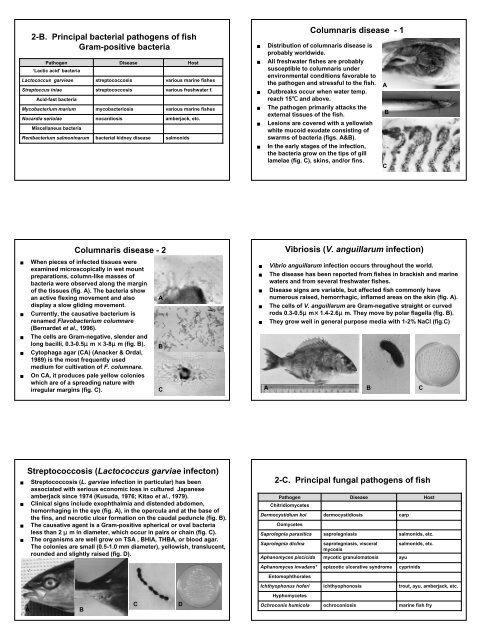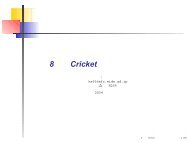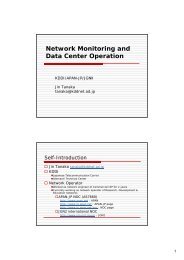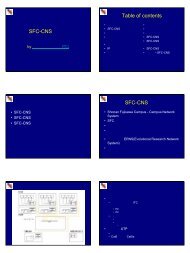DISEASE PROBLEMS IN FISH FARMING - SOI-Asia
DISEASE PROBLEMS IN FISH FARMING - SOI-Asia
DISEASE PROBLEMS IN FISH FARMING - SOI-Asia
You also want an ePaper? Increase the reach of your titles
YUMPU automatically turns print PDFs into web optimized ePapers that Google loves.
2-B. Principal bacterial pathogens of fish<br />
Gram-positive bacteria<br />
Pathogen<br />
‘Lactic acid’ bacteria<br />
Lactococcus garvieae<br />
Streptoccus iniae<br />
Acid-fast bacteria<br />
Mycobacterium marium<br />
Nocardia seriolae<br />
Miscellaneus bacteria<br />
Renibacterium salmoninarum<br />
streptococcosis<br />
streptococcosis<br />
mycobacteriosis<br />
nocardiosis<br />
Disease<br />
bacterial kidney disease<br />
various marine fishes<br />
various freshwater f.<br />
various marine fishes<br />
amberjack, etc.<br />
salmonids<br />
Host<br />
<br />
<br />
<br />
<br />
<br />
<br />
Columnaris disease - 1<br />
Distribution of columnaris disease is<br />
probably worldwide.<br />
All freshwater fishes are probably<br />
susceptible to columnaris under<br />
environmental conditions favorable to<br />
the pathogen and stressful to the fish.<br />
Outbreaks occur when water temp.<br />
reach 15and above.<br />
The pathogen primarily attacks the<br />
external tissues of the fish.<br />
Lesions are covered with a yellowish<br />
white mucoid exudate consisting of<br />
swarms of bacteria (figs. A&B).<br />
In the early stages of the infection,<br />
the bacteria grow on the tips of gill<br />
lamelae (fig. C), skins, and/or fins.<br />
A<br />
B<br />
C<br />
<br />
<br />
<br />
<br />
<br />
Columnaris disease - 2<br />
When pieces of infected tissues were<br />
examined microscopically in wet mount<br />
preparations, column-like masses of<br />
bacteria were observed along the margin<br />
of the tissues (fig. A). The bacteria show<br />
an active flexing movement and also<br />
display a slow gliding movement.<br />
Currently, the causative bacterium is<br />
renamed Flavobacterium columnare<br />
(Bernardet et al., 1996).<br />
The cells are Gram-negative, slender and<br />
long bacilli, 0.3-0.5m 3-8m (fig. B).<br />
Cytophaga agar (CA) (Anacker & Ordal,<br />
1989) is the most frequently used<br />
medium for cultivation of F. columnare.<br />
On CA, it produces pale yellow colonies<br />
which are of a spreading nature with<br />
irregular margins (fig. C).<br />
A<br />
B<br />
C<br />
<br />
<br />
<br />
<br />
<br />
Vibriosis (V. anguillarum infection)<br />
Vibrio anguillarum infection occurs throughout the world.<br />
The disease has been reported from fishes in brackish and marine<br />
waters and from several freshwater fishes.<br />
Disease signs are variable, but affected fish commonly have<br />
numerous raised, hemorrhagic, inflamed areas on the skin (fig. A).<br />
The cells of V. anguillarum are Gram-negative straight or curved<br />
rods 0.3-0.5m1.4-2.6m. They move by polar flagella (fig. B).<br />
They grow well in general purpose media with 1-2% NaCl (fig.C)<br />
A B C<br />
<br />
<br />
<br />
<br />
Streptococcosis (Lactococcus garviae infecton)<br />
Streptococcosis (L. garviae infection in particular) has been<br />
associated with serious economic loss in cultured Japanese<br />
amberjack since 1974 (Kusuda, 1976; Kitao et al., 1979).<br />
Clinical signs include exophthalmia and distended abdomen,<br />
hemorrhaging in the eye (fig. A), in the opercula and at the base of<br />
the fins, and necrotic ulcer formation on the caudal peduncle (fig. B).<br />
The causative agent is a Gram-positive spherical or oval bacteria<br />
less than 2 m in diameter, which occur in pairs or chain (fig. C).<br />
The organisms are well grow on TSA , BHIA, THBA, or blood agar.<br />
The colonies are small (0.5-1.0 mm diameter), yellowish, translucent,<br />
rounded and slightly raised (fig. D).<br />
A<br />
B<br />
C<br />
D<br />
2-C. Principal fungal pathogens of fish<br />
Pathogen<br />
Chitridiomycetes<br />
Dermocystidium koi<br />
Oomycetes<br />
Saprolegnia parasitica<br />
Saprolegnia diclina<br />
Aphanomyces piscicida<br />
Aphanomyces invadans*<br />
Entomophthorales<br />
Ichthyophonus hoferi<br />
Hyphomycetes<br />
Ochroconis humicola<br />
saprolegniasis<br />
saprolegniasis, visceral<br />
mycosis<br />
mycotic granulomatosis<br />
epizootic ulcerative syndrome<br />
ichthyophonosis<br />
ochroconiosis<br />
Disease<br />
dermocystidiosis<br />
carp<br />
salmonids, etc.<br />
salmonids, etc.<br />
ayu<br />
cyprinids<br />
Host<br />
trout, ayu, amberjack, etc.<br />
marine fish fry










